November 1998
The Down's Syndrome Association
155 Mitcham Road
London SW17 9PG, UK
0181-682 4001 Fax: 0181-682 4012
|
Stephanie Lorenz November 1998 |
Reprinted with the permission of Susannah Seyman, Information Officer The Down's Syndrome Association 155 Mitcham Road London SW17 9PG, UK 0181-682 4001 Fax: 0181-682 4012 |
Over the last 15 years, since the implementation of the 1981 Education Act, there has been a slow but steady growth in the number of children with Down's syndrome attending mainstream schools. While at first few remained in the mainstream beyond 11, increasing numbers are now completing their education alongside normally developing peers. Nevertheless, there is still considerable local variation in practice, with some LEAs committed to special education for all but the most able, while others are moving steadily towards greater inclusion.
However, even within the mainstream, there is enormous variability in what is considered to be inclusive practice. In some schools, children with Down's syndrome are accompanied by a learning support assistant (LSA) throughout the day, with little opportunity to make friends or act independently. In others support is unobtrusive and designed to build bridges between the child and the curriculum without impeding the development of relationships.
While most LEAs profess to assess each child individually and provide a package of support tailored to meet that child's needs, experience suggests that levels of support are influenced more by history and practice within that particular area than by individual need. Particular schools and parents also appear to exert a considerable influence on the level and nature of the support offered.
Parents and professionals working with children with Down's syndrome are able to call on a growing body of anecdotal evidence to illustrate their perceptions of the current state of inclusive education in Great Britain. Nevertheless, there is to date no published research to substantiate their impressions. The current study aims, at least in part, to remedy this situation.
In the summer of 1997, a questionnaire was drawn up and piloted with a group of parents and teachers from both the primary and the secondary sector. Some of the teachers who took part expressed concern about passing on detailed information about school procedures without reference to their headteacher or the LEA. Others doubted that the average teacher would be able to find the time to complete a four or five page questionnaire. Parents on the other hand had no major problems, although many were unable to answer all the questions without reference to their child's school.
While the initial idea had been to use both parent and teacher responses, the final decision was to circulate questionnaires via parents alone, but to invite them to consult with their child's school in gathering the information. With the help of the Down's Syndrome Association, the Down's Syndrome Educational Trust and a range of other groups, flyers inviting parents to request a questionnaire (Appendix 1) were distributed widely. The initial flyers went out to parents in September 1997 and requests for questionnaires were received steadily until the end of July 1998. All responses, therefore, refer to the 1997/8 school year.
Most parents requesting a questionnaire were spoken to personally to ensure that their child was in full time mainstream education. Responses from parents with mixed placements, or who had children of nursery age, were rejected as the questions would not have been appropriate. Similarly, parents whose children had recently transferred to a special school or who had just left school were also rejected as the study was specifically designed to look at contemporary practice.
In total 431 questionnaires (Appendices 2a & b) were sent out and 319 returned, a response rate of 74%. They came from 107 LEAs in England, Wales, Scotland, Northern Ireland, the Isle of Man and Jersey (Appendix 3).
For children in Key Stage 1 (between 4 and 6 years of age in September 1997) 122 responses were received (59 girls and 63 boys) from 70 different LEAs. Of these pupils 60% attended primary schools catering for pupils from 4-11, 32% attended infant schools for pupils from 4-7 and 8% attended first schools, catering for children from 4-8.
For those in Key Stage 2 (between 7 and 11 years of age) there were 143 responses (86 girls and 57 boys) from 76 different LEAs. Of these 69% attended primary schools, 16% attended junior schools for pupils from 7-11, 6% attended first schools, 6% were in middle schools for pupils from 8-12 and 3% were still in infant schools.
At Key Stage 3 (aged 11-14) there were 38 responses (14 girls and 24 boys) from 29 LEAs, while at Key Stage 4 (aged 15-16) there were 14 responses (7 girls and 7 boys) from 13 LEAs. 22% were in middle schools, 3% in high schools for pupils of 13+ and the remaining 75% in secondary schools for pupils from 11+.
The picture overall can be seen in Fig.1. From the data, it is clear that there is a progressive decrease in the number of children included in mainstream schools as they pass from one Key Stage to the next. While the drop off between Stages 1 & 2 and between Stages 3 & 4 is relatively small, there are significantly fewer children with Down's syndrome in secondary than in primary schools.
When the sexes are considered separately, it emerges that while the number of girls in Key Stages 1 & 2 remains very much the same, the number of boys reduces significantly between the infant and junior phases of education. One conclusion which might be drawn is that since, in the early years at least, boys are generally less advanced in language and related cognitive skills. They may be perceived as less able to access the Key Stage 2 curriculum. Alternatively, boys may be seen as presenting more impulsive and distractable behaviour and so become less acceptable as academic demands increase.
At secondary level, while numbers are much smaller, age and sex differences still occur. However, it should be noted that the students in Key Stage 4 at the time of the survey would have entered school prior to the implementation of the 1981 Education Act. This factor may be sufficient to account for the difference in total numbers within Key Stages 3 & 4, rather than placement failure. On the other hand it cannot explain the marked sex difference observed in Key Stage 3, where boys outnumber girls on a ratio of nearly 2:1. No convincing explanation for this phenomenon can be offered at this stage. Possibly it is a random effect within a very small sample. Alternatively it might be that boys of this age tend to be less verbal and quieter than girls and are therefore seen as less challenging.
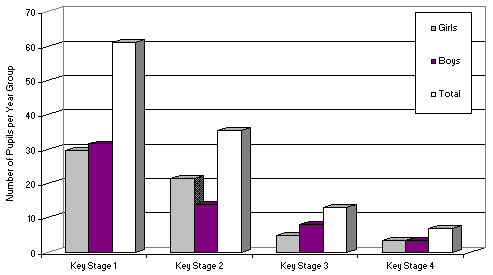
For those children in Key Stage 1, 67% were placed with other children of the same age, 29% were a year behind and 4% were taught with children two years younger (see Fig.2). The average class size was 26 pupils, with a range from 10 to 39. Although particularly small or large classes were exceptional, 17% of children were in classes of more than 30, while 8% were placed in classes of less than 20 pupils.
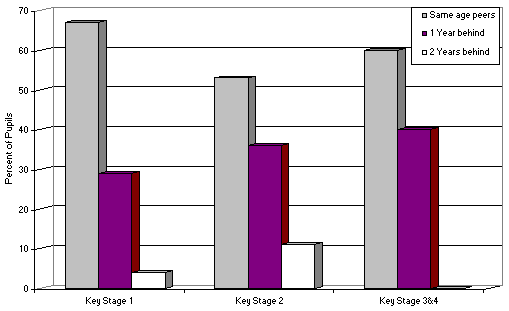
For those children in Key Stage 2 at the time of the survey, class sizes had increased somewhat with an average of 29 pupils. Only 4% were in classes of less than 20 while 31% were in classes of over 30. More significantly, the proportion of children kept back had increased. By this stage, only 53% of children were being taught with same age peers, with 36% a year behind and 11% two years behind.
What is not clear is whether this reflects a change in practice over time, with progressively fewer children starting school a year late, or whether it indicates that some children were being held back later in their school career. In either case, the practice reflects a fairly widespread misconception that, by placing children with Down's syndrome in a class of younger pupils, their special needs will become less apparent and the need to differentiate their work minimised. In reality, the curriculum match almost invariably remains elusive and extensive individualisation of work is still required. Further, where children are kept back part way through their school career, social relationships may be disrupted and the child become increasingly isolated.
Of students in Key Stages 3 & 4, 60% were placed with same age peers and 40% were a year behind. No secondary student in the survey was kept down more than a year, suggesting that those children who were two or more years behind in the primary phase would almost certainly have transferred to special school at 11. On the other hand, moving up the primary school with peers a year younger does not appear to prevent successful transfer to mainstream secondary, since a fairly constant proportion of those included in mainstream schools progressed through their school career with peers a year younger.
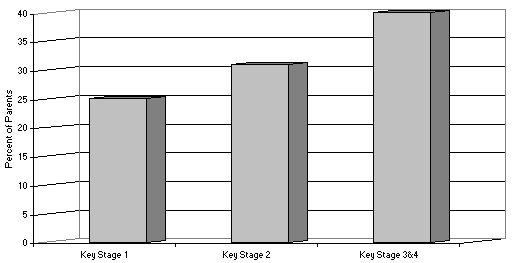
All but one child in the survey received support from a learning support assistant (LSA) for at least part of the week. In some instances this support was provided by the same assistant throughout the week, in others by two or more. In Key Stages 1& 2, only 5% of pupils had more than one assistant. However, in Key Stages 3 & 4, 53% of students were being supported by more than one LSA, 19% of the age group having different assistants in different subject areas.
In Key Stage 1, children received on average 23 hours LSA support, with a range from 1.5 to 37 hours per week. In some instances this support included cover for breaks or lunchtimes. In others it was confined to the classroom or used for withdrawal sessions. In only two instances was support shared with another statemented child. As can be seen from Fig.4, 7% of children received 10 hours support or less, 15% 11 - 15 hours, 21% 16 - 20 hours, 24% 21-25 hours and 33% 26 hours or more.
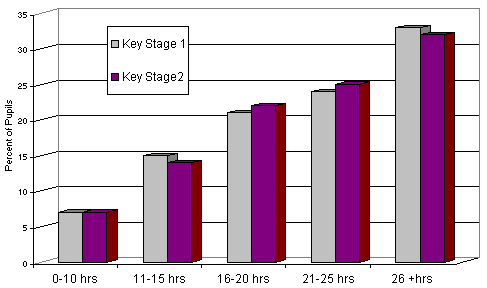
In Key Stage 2, the pattern of support was very similar, with a range from 3-35 hours. However, the average level was reduced slightly to 20 hours and 8% of children were sharing their support with another statemented child. Overall, 7% of children in Key Stage 2 were receiving 10 hours support or less, 14% 11-15 hours, 22% 16-20, 25% 21-25 and 32% 26 hours or more (see Fig.5).
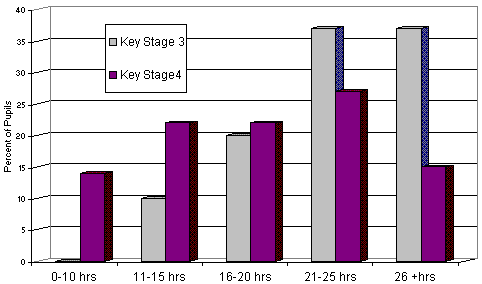
While levels of support appeared to be reduced somewhat as children moved from Key Stage 1 into Key Stage 2, they rose again once children transferred to the secondary sector. The average level of LSA support in Key Stage 3 was 24 hours per week, although it fell back to 19 hours for those students in Key Stage 4. In 25% of instances, this support was shared with other statemented children. In addition, 60% of pupils in Key Stages 3 and 4 received some in-class support from an additional teacher.
In considering the role of the learning support assistant in supporting a child with Down's syndrome it is important to be aware of the level of training undergone by these key members of the school staff. For those working in Key Stage 1, 49% had an additional relevant qualification. 35% were qualified nursery nurses, 6% had obtained a City & Guilds Certificate in Learning Support, 5% had an NVQ in Child Care or a recognised playgroup qualification and 3% were qualified teachers employed as LSAs. 38% of LSAs in Key Stage 1 had received some additional training in teaching children with Down's syndrome while 16% of the total had attended a Makaton course, had received Portage training or had attended a general special needs course run by the LEA. Some LSAs had attended two or more forms of training. However 24% had received no training of any sort (See Fig.6).
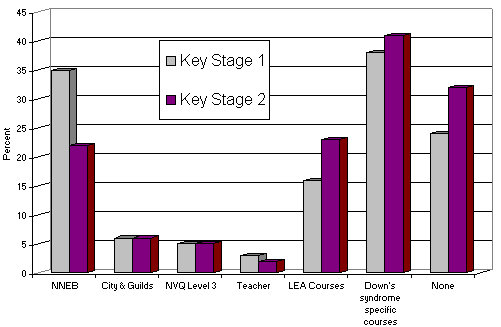
In Key Stage 2 only 35% of LSAs had an additional qualification. 22% were qualified nursery nurses, 6% had a City & Guilds Certificate or had attended a course for Specialist Teaching Assistants. 5% had an NVQ Level 3 or equivalent and 2% were qualified teachers. 41% of LSAs had received some additional training in teaching children with Down's syndrome and 23% had attended other relevant LEA courses. However, 32% of LSAs supporting children in Key Stage 2 had received no additional training.
When the 62 LSAs supporting pupils in Key Stage 3 were considered, the level of training fell even further, with only 33% being additionally qualified. Within this group, the relevance of training such as that for the NNEB must be questioned, as it focuses on the needs of the under 8s. 10% had a City & Guilds Certificate in Learning Support, 8% were qualified nursery nurses, 7% were qualified teachers, 5% had an NVQ, 3% were trained nurses and 1 had a youth work qualification. 32% of the total had attended a Down's syndrome specific course while 14% had attended other training offered by the LEA. 54% of the total group had received no training at all (see Fig.7).
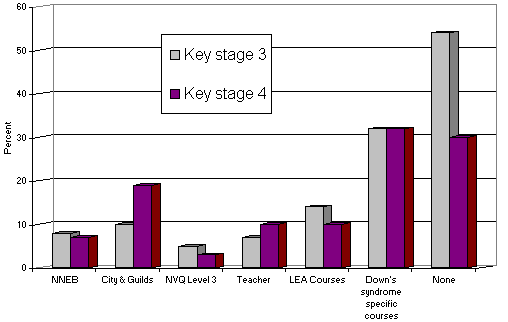
For the 31 LSAs supporting students in Key Stage 4, levels of training were somewhat higher with 39% having an additional qualification. 19% had a City & Guilds certificate, 10% were qualified teachers, 7% had an NNEB and 3% an NVQ. 32% had attended a Down's specific course and 10% other LEA training. A total of 29% had received no training of any kind.
In considering the experience of children with Down's syndrome in a mainstream setting, the role adopted by their LSA is crucial. The aims of any inclusive placement should be fourfold:
Since a significant proportion of LSAs have received no training, either before or after taking up their post, the input of qualified teaching staff is essential if high quality learning experiences are to be provided. These can be offered directly by the class teacher or indirectly by the LSA via joint planning and the preparation of modified teaching materials.
Survey data indicated that at Key Stage 1, the class teacher worked directly with the child on a daily basis in 51% of instances and weekly in a further 22%. In 27% of cases, children with Down's syndrome received little if any direct input from their class teacher. Indirect teacher support via the provision of special work was provided in 60% of instances, but only 16% of LSAs in Key Stage 1 had regular opportunities for joint planning with the class teacher. In Key Stage 2 the picture was even bleaker, with only 42% of children receiving daily teacher input and 25% input on a weekly basis. This left 33% of children in Key Stage 2 without any regular input from a qualified teacher. On the other hand, 69% of Key Stage 2 teachers were involved in providing special work for the child and 43% of LSAs in Key Stage 2 had extra time for planning.
In the secondary sector, the picture was rather more complex as 56% of students in Key Stages 3 & 4 received regular in-class support from a support teacher as well as from their LSA. Further, some teacher input was offered within the classroom and some on a withdrawal basis. This differed significantly from the position at primary level where almost all withdrawal teaching was provided by an LSA. In Key Stage 3, 60% of students received input from a qualified teacher on a daily basis and 24% on a weekly basis. Only 16% of pupils received no direct input from a qualified subject teacher or a member of the school's support department. In Key Stage 4, the situation was even more marked, with 86% of students receiving direct teacher input on a daily basis. Only one student in the survey received weekly help and one no direct teacher input at all. The overall position can be seen in Fig.8.
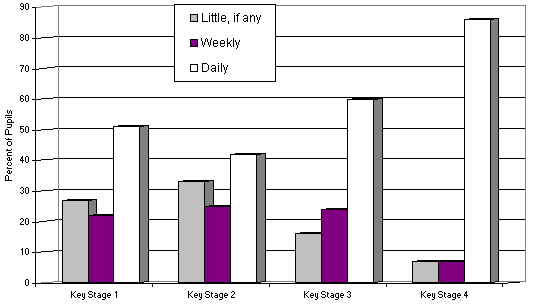
One of the major problems that has emerged from studies of inclusive education for children with Down's syndrome is that schools, in attempting to maximise children's learning, have provided too much support. As a consequence, children are prevented from learning by making mistakes or operating independently. The issue, however, is not just about how many hours of support are available, but also about how that support is used.
In Key Stage 1, 29% of learning support assistants sat beside their target child most of the time, rarely if ever working with other children in the class. In 12% of cases, the LSA, while alongside the child most of the time, also supported other children in the group. Where LSA hours were limited, or where the development of independence had been prioritised, LSAs were giving help only part of the day, although they did not support other children. This situation was found in 23% of cases. Finally, in 36% of instances support was provided flexibly across the whole class as and when required (see Fig.9).
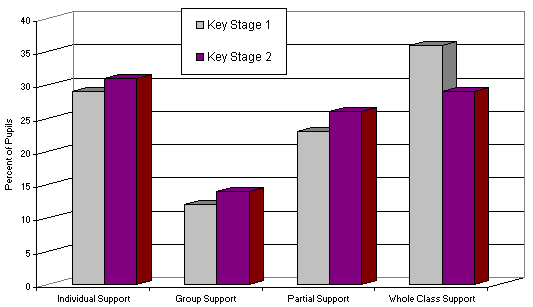
A similar picture was presented in Key Stage 2 with 31% of LSAs working exclusively with their target child throughout the day and 14% working with the child in a group. In 26% of cases the child received part-time or flexible support but no regular input was offered to other children, while LSAs worked across the whole class in 29% of instances.
At Key Stage 3, the level of close support increased significantly with 62% of students supported individually throughout the day and 5% supported in a group (see Fig.10). This practice reflects the relatively low level of involvement shown by subject staff at Key Stage 3 where schools often rely on input from qualified support teachers. However, there is a real risk that students who are supported individually for most of the day will become dependent on support and will fail to develop problem solving strategies. A further 9% of pupils received partial support, without additional input to other pupils, while in 24% of instances support was provided flexibly across the class.
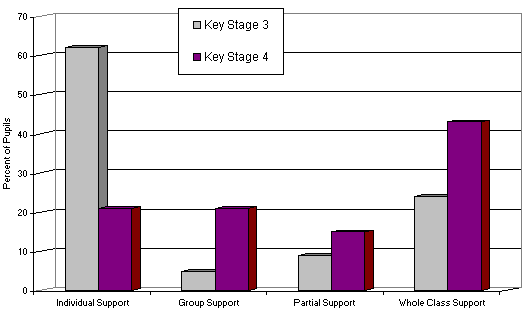
At Key Stage 4 the picture was very different with only 21% of students being closely supported. A further 21% were supported in a group, 15% received help for part of the day, while 43% of schools used support flexibly across the whole class.
In order to develop relationships with other members of their peer group, it is important that children with Down's syndrome have regular opportunities to mix and play without close adult supervision. Individual support which extends beyond the classroom can interfere with the formation of friendship patterns, as well as preventing the child becoming an independent member of the school community. Close 1:1 support and regular withdrawal from the classroom can also interfere with relationship building, as the child has fewer opportunities to interact with peers.
In Key Stage 1, 50% of children had individual support at playtime, 57% at lunchtime and 59% during assembly (see Fig.11). In addition, 29% were withdrawn individually at least once a day and 12% in a small group (see Fig.12). By Key Stage 2, only 28% were being supported at playtime and 31% at lunchtime and during assembly. On the other hand, 79% of children were being withdrawn on a daily basis, either individually (66%) or in a group (13%).
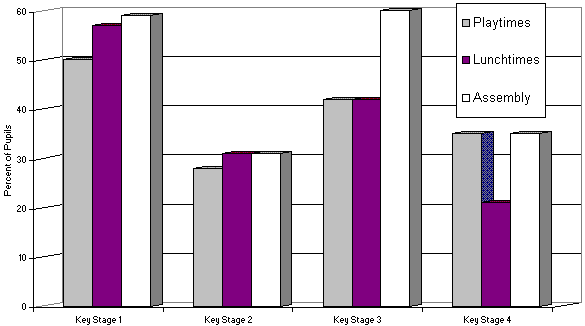
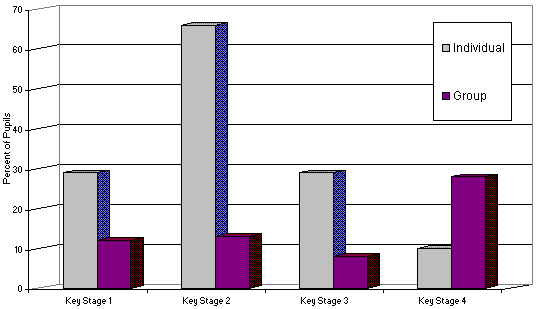
For students in Key Stage 3, levels of supervision increase significantly with 42% being supported individually at break and lunchtime and 60% during assembly. On the other hand, 40% attended lunchtime or after school clubs without extra support and 45% had a "Circle of Friends", which further aided the development of friendships. While support outside the classroom increased, withdrawal in Key Stage 3 was rather less frequent with only 37% of pupils being withdrawn each day, either individually/with one other child (29%) or in a group (8%).
At Key Stage 4, support outside the classroom was reduced again with only 35% of students being supported at break and during assembly and 21% at lunchtime. 43% of pupils attended school clubs and 36% had a "Circle of Friends". While 35% of students were still being withdrawn on a daily basis, only 7% were taught individually with 28% being helped in a group.
To help children with delayed development adopt age-appropriate behaviours, it is important that they are in regular contact with relevant models. Thus, placing the child with peers two or more years younger is likely to delay their social development still further. Similarly, placing a secondary aged student in a bottom set or special class, with poorly motivated pupils, may result in the child copying inappropriate behaviours.
Data from the survey indicate that at key stage 3, 18% of students were placed in lower sets for maths only, 39% for up to 5 subjects and 11% for all core and foundation subjects. 32% were in mixed ability groups or middle sets throughout the week. In key stage 4, 32% were in bottom sets for maths, 38% for up to 5 subjects and 15% for all main subjects. 15% of students remained in mixed ability groups or with more able peers (see Fig.13).
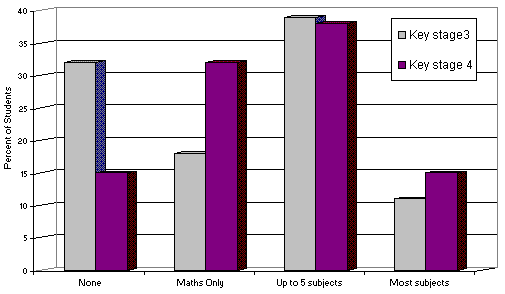
While it is well known that the majority of children with Down's syndrome have delayed language and experience difficulties with articulation, only a proportion receive regular input from a speech therapist. Similarly, despite co-ordination problems, few children receive regular input from an occupational therapist or physiotherapist. Survey data indicated that 29% of children in Key Stage 1 received weekly speech and language therapy, although in one case this was paid for privately by the parents and in two more instances was only available at the local clinic. 43% received termly visits from a therapist and regular language support in the classroom, while 28% had no speech therapy input at all, 13% having a specific language programme but no therapy, while in 15% of cases no specific language work was being offered at all (see Fig.14). In contrast, only 8% of children received regular occupational therapy or physiotherapy - 1% on a weekly basis and 7% termly.
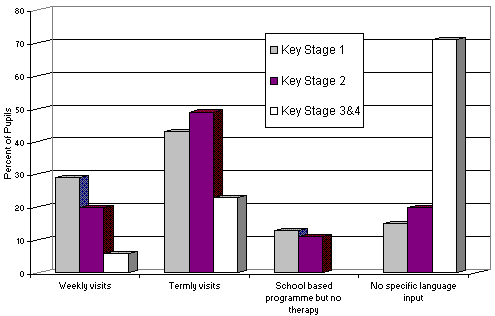
In Key Stage 2 the situation was very similar with 20% of children receiving weekly speech therapy and 49% receiving termly input together with a language programme. At this level, 11% received only a school based language programme and 20% no specific language input at all. Regular occupational therapy or physiotherapy was received by less than 1% of children. When asked what would improve their child's provision, 18% of primary parents mentioned the need for more school based therapy.
For students in Key Stages 3 & 4, only 29% still received regular speech and language therapy with 6% seeing a therapist weekly and 23% termly. Overall, 71% of students received no specific language input and only two students received regular occupational or physiotherapy input.
In looking at those schools best able to meet the needs of children with Down's syndrome, the support offered to the school is as important as that provided for the child. When questioned about ways of making their child's placement more successful, 23% of parents felt that additional focused training for school staff was required. A further 5% talked of the need for more advisory input.
15% of primary schools received weekly input from an advisory teacher. In 6% of instances this was on an outreach basis from a special school. A further 39% of schools received termly visits from a specialist teacher or educational psychologist, while 46% had no advisory input at all. At secondary level the position was even worse with only 11% of schools receiving weekly, and 16% termly, advisory visits (see Fig.15).
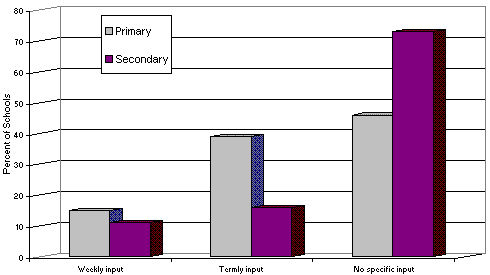
Of particular interest in this context is the influence of the origin of support staff on school practice. Those receiving outreach support from a special school or special needs advisory centre are most likely to withdraw children from the rest of the class and give close 1:1 supervision, with the class teacher having little direct involvement with the child. Those receiving input from a psychologist tend to be rather more inclusive in their practice, while the most inclusive practice was found in those schools obtaining their advice from an LEA advisory teacher (see Fig.16).
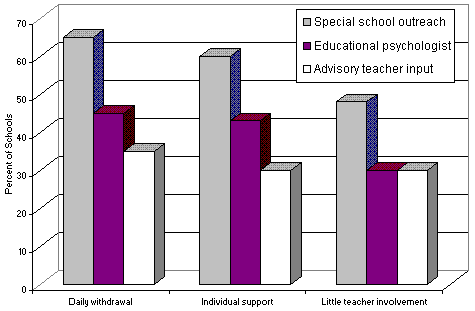
There was a significant difference in the frequency of support visits from LEA support services and special school outreach. While 68% of special school support teachers visited weekly, only 31% of LEA advisory teachers did so. It is reasonable to speculate that weekly input from an "expert" could allow the class teacher to opt out of active involvement, leaving responsibility for the child's programme in the hands of the visiting teacher and the child's LSA. However, when comparing only those schools receiving weekly input, a significant difference in school practice between those receiving LEA advisory teacher and special school outreach support still remains (see Fig.17). Also, those schools receiving weekly special school input actually withdrew less often than those receiving termly visits. It is clear that the key factor could be one of attitude of those supporting rather than the frequency of support. If special schools are to become more involved in outreach, as the Government suggests, some thought will clearly need to be given to developing their skills and understanding of inclusion.
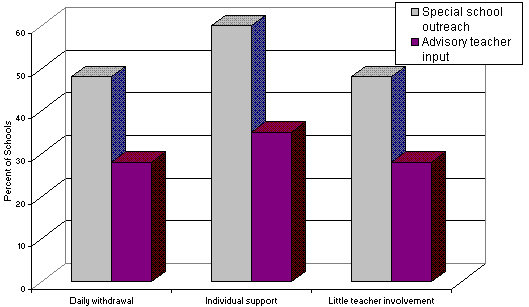
To be effective in meeting special needs, it is important that schools work closely with parents. 12% of the parents in the survey cited poor communication and negative attitudes within the school as a serious weakness of their child's placement. In the primary phase, 43% of parents discussed their child's progress with school staff at least once a week. 50% at least once a term and 7% only when thought necessary by parents or school or for formal reviews (see Fig.18). 6% of primary schools used a home-school diary on a daily basis. No significant differences were noted between the first two Key Stages although home-school books were somewhat more common in Key Stage 2. In the secondary sector, 19% of parents went into school weekly, 52% termly and 29% annually. On the other hand, home-school diaries were used on a daily basis in 13% of cases.
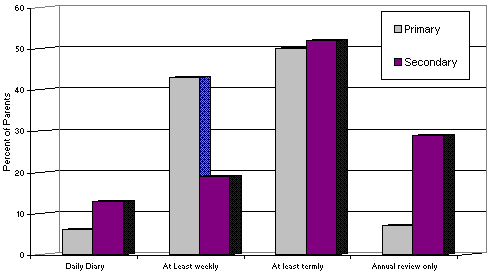
At primary level, 86% of parents communicated regularly with their child's LSA, 89% with the class teacher, 37% with the SENCO and 36% with the headteacher (see Fig.19). In the case of review meetings, 85% of primary schools invited the LSA, 88% the classteacher, 82% the SENCO and 78% the headteacher (see Fig.20).
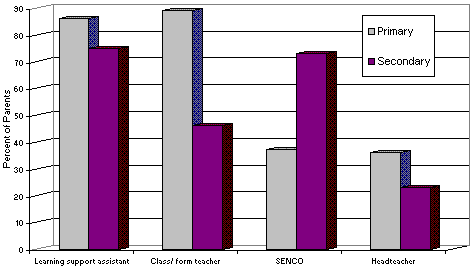
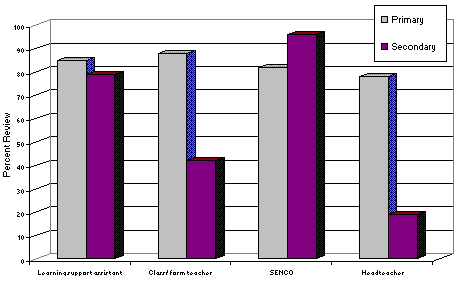
At secondary level, 46% of parents talked to the form tutor on a regular basis, 75% to the LSA, 73% to the SENCO and 23% to the head. In secondary schools, LSAs attended 79% of reviews, form tutors 42%, SENCOs 96% and headteachers 19%.
Finally, the survey indicated that, on average, 84% of parents were content with the support that their child was being offered. Interestingly, levels of satisfaction increased as the child got older. Only 75% of parents with children in Key Stage 1 were satisfied, as compared with 85% in Key Stage 2 and 92% at secondary level. Nevertheless, an average of 43% of parents still made suggestions about how things could be further improved, decreasing from 48% in Key Stage 1 to 40% in Key Stages 3 & 4 (see Fig.21). These figures, while far from ideal, suggest that parents and schools working together over time can improve the quality of support offered to pupils with Down's syndrome in mainstream schools.
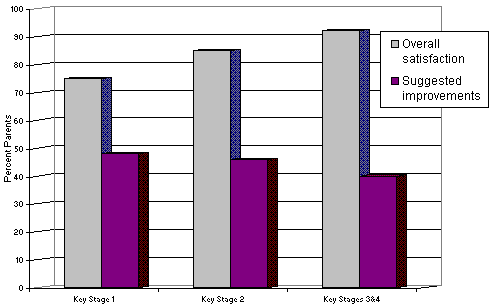
The data obtained from the current research confirm that across the country there are significant differences in access to and in quality of provision for children with Down's syndrome. While each child is unique, it seems most unlikely that individual differences are sufficient to justify the wide differences in practice and provision found in the study. Although the majority of parents are pleased with their experience of inclusion and feel that their child has benefited, it is clear that much still needs to be done to provide high quality provision for all.
To improve practice, the following recommendations are made: